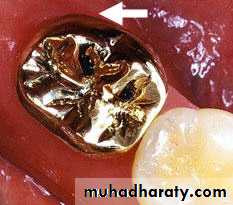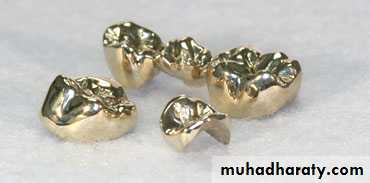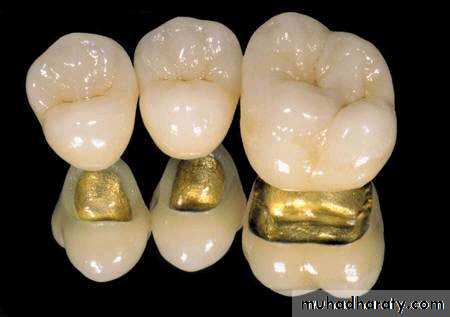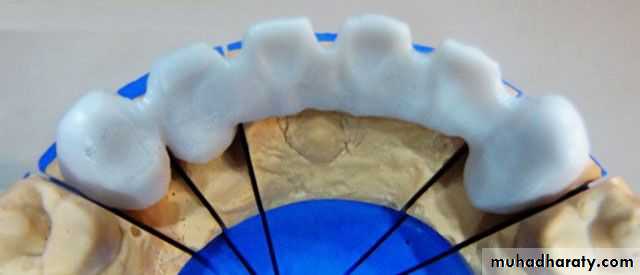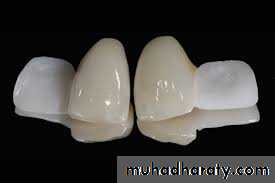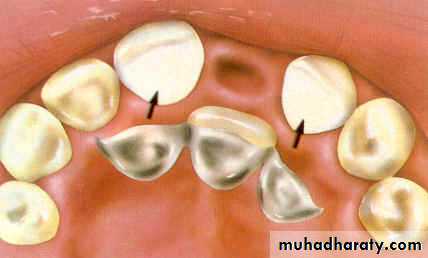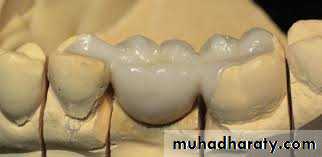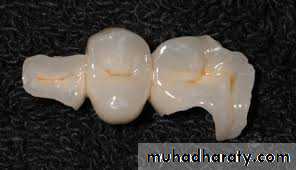Types of Retainers
Dr. Ahmed JawadRequirements of retainer
• Biocompatable• Withstand the masticatory forces
• Restore the anatomy of the tooth
• Pulp consideration
Requirements of retainer
• Strong enough to resist deformation under functional stress• Esthetically acceptable
• Maintain oral hygiene
Criteria for selection of retainers
• Degree of retention required• Surface area of the abutment
• Periodontal condition
• Effective root surface area
• Crown root ratio
• Condition of the abutment teeth
• Preservation of tooth structure
• Relation with the opposing teeth
• Material used for bridge construction
• Alignment of teeth
1- Degree of retention required
It represent the most important criterion,
The factors that affect retention are:
• Length of the span:
Longer the span the greater the stress on the retainers, so the components of the bridge must be stronger
• Type of the bridge:
Stronger retainers are required for fixed-fixed bridge than fixed-movable bridge to withstand the stress on the cementing media
1- Degree of retention required
• Strength of the bite:It varies according to age sex and muscular development of the patient.
Heavier bite requires stronger and thicker metal to prevent failure of retainers
• Tooth or teeth to be replaced
Size and position of pontic have a direct effect on type of retainer, for example: replacement of molar impart great stress to abutment than lower central.
1- Degree of retention required
• Articulation:Errors in articulation affect the selection and the design of the retainer.
Correction of any supra erupted tooth opposing pontic area is done prior to construction of a bridge
• Habits of the patient:
Bruxism patient should be given thicker and stronger retainer than normal because of their excessive clenching
Criteria for selection of retainers
2- Surface area of the abutment tooth, the surface area of lower molar is greater than that of a canine so the use of molar as abutment will increase the retention.
3- Periodontal condition: in cases of gingival recession the finish line should be placed supragingivally to minimize gingival irritation, but this will reduce the surface area of the abutment tooth and decrease the retention.
Criteria for selection of retainers
4- Effective root surface area: single rooted teeth have less effective root surface area than multirooted teeth, also periodontally diseased teeth have a compromised root surface area.5- Crown root ratio: this depends on the degree of eruption of the tooth and on the degree of gum recession.
Criteria for selection of retainers
6- Condition of the abutment: partial veneers crowns are indicated for non carious abutments, while full veneer crowns used for large carious abutments. Endodontically treated teeth requires post and core.7- Preservation of tooth structure:
Partial > full veneer > all ceramic
Criteria for selection of retainers
8- Relation with the opposing teeth.9- Material used for bridge construction.
10- Aligment of teeth.Classification of retainers
Extra-coronal retainers
Full coverage restorationsThese are restorations used to restore the all surfaces of the clinical crown. And are classified according to the material used in their construction, as:
1. Metal crowns
2. Non-metal crowns
3. Combination of both of the two above.
Metal crown
It is an artificial metallic restoration used to cover all the surfaces of the clinical crown.It is made only from metal, e.G. Gold.
1. As single crown or as a bridge (retainer for FPD).
2. Only for posterior teeth (where there is a sever occlusal stress).3. In patient with high caries index.
4. For an endodontically treated tooth.
5. For malalignment tooth/or teeth.
6. For teeth with a short occluso-gingival height.
7. For a badly broken clinical crown.
8. In a long span bridge.
1. In case of anterior teeth, for esthetic reasons.
2. In a situation where another conservative preparation can be use (e.G. Partial coverage).
3. When less than maximum resistance and retention is needed.
4. When caries extend gingivally, as that the finish line cannot be made.
5. In case of uncontrolled caries.
1. Great resistance form.
2. Great retention.3. High strength.
4. Good protection for a tooth to be restored.
5. Can modify occlusion in case of overeruption.
6. Can modify tooth contour in case of open contact or in
buccal or lingual contour in a tooth used as a retainer for FPD.
7. Ideal restorations for teeth with developmental defects.
1. Bad esthetics (especially for anterior
teeth).2. Pulp vitality can not be detected.
3. Incipient caries can not be detected.
4. Extensive amount of tooth reduction.
Combined crowns
Known as :
- Porcelain Fused to Metal
crowns (PFM), or
- Metal ceramic crowns.
1. On teeth require esthetic.
2. In case of extensive tooth destruction as a result of caries, trauma, or existing previous restorations.3. When there is a repeated failure of PJC.
4. When superior retention and resistance is needed.
5. In case of an endodontically treated tooth.
6. To recontour axial surfaces or correct minor malinclinations of teeth.
1. In patient with active caries or untreated periodontal disease.
2. In young patient with large pulp chamber because of the high risk of pulp exposure.3. Where a more conservative restoration can be made.
1. Have the strength of cast metal crowns with the esthetic of the all ceramic crowns
2. Have good retention.
3. Permit easy correction of the axial walls.
1. Their preparation requires more tooth reduction to provide sufficient space for the restorative materials.
2. Their facial margins for anterior teeth, is often placed subgingivally which increase the risk for periodontal disease.
3. The laboratory casts are expensive.
4. A frequent problem is the difficulty of accurate shade selection.
All ceramic zirconia bridge
1. For anterior teeth (especially incisors).
2. For severely discolored anterior teeth.3. Over an existing post and core substructure.
1. Parafunctional habits
2. In case of tooth with short clinical crown (noenough tooth structure to support the porcelain).
3. In case of edge to edge or overbite occlusion.
4. Reduced inter-occlusal space
1. Have the best cosmetic effect of all dental restorations.
2. High strength
3. biocompatable
4. excellent insulation
• 1. Expensive as it requires CAD/CAM system
• 2. Bond between the ceramic veneer and the zirconia framework is the weakest component of the layered structure.




